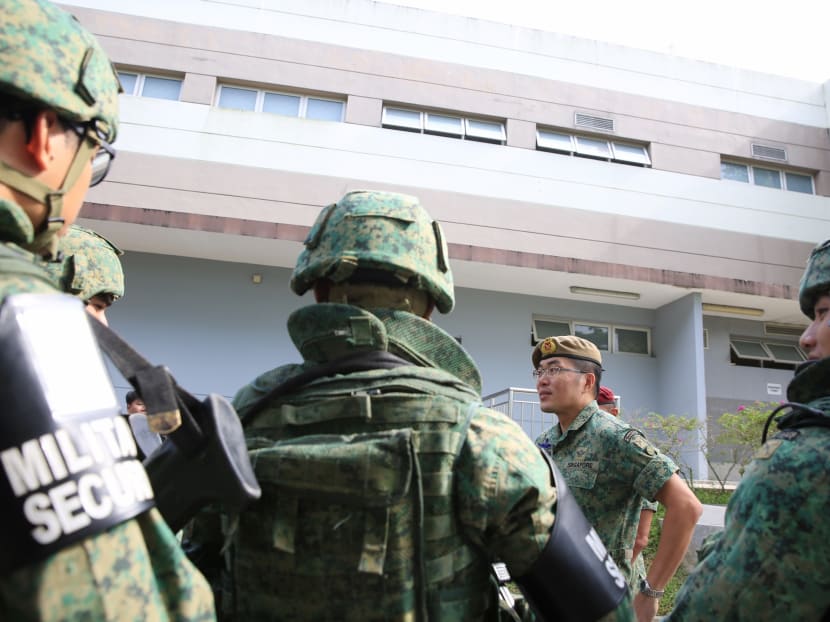Army to customise fitness training for different vocations
SINGAPORE — Servicemen could see fitness training tailored to their vocations to help prevent injuries, as the Army looks to make every soldier count, amid manpower challenges brought on by falling birth rates.

Chief of Army Melvyn Ong speaking with SAF soldiers during a visit to the Murai camp on June 29, 2016. Photo: Koh Mui Fong/TODAY
SINGAPORE — Servicemen could see fitness training tailored to their vocations to help prevent injuries, as the Army looks to make every soldier count, amid manpower challenges brought on by falling birth rates.
The Army is also looking into improving its rehabilitative facilities, so servicemen can recover and be brought “back to the fold”, Chief of Army Melvyn Ong said in a wide-ranging interview with the media ahead of Singapore Armed Forces (SAF) Day on Friday (July 1).
To do this, a new Centre of Excellence for Soldier Performance (CESP) will be set up to redesign fitness training curriculum and look into areas such as vocation fitness training, how equipment can be designed to suit individuals and vocations, and even nutrition in cookhouses.
By 2030, the pool of full-time national servicemen (NSFs) is expected to shrink by one-third. Against this backdrop, the Army recognises that “every soldier counts” and wants to build up soldiers so they possess a “strong body, strong mind and strong heart”.
As part of a trial, soldiers in the 4th Battalion, Singapore Infantry Regiment (4SIR) were put through a month-long fitness training programme tailored to their vocation — with encouraging results.
“We’ve found that injury prevention is very high — it’s a lot higher than before,” Major-General (MG) Ong said, noting that the Army wanted to press on with this.
To mould soldiers with “strong minds”, it will ramp up training in resilience, as part of efforts to help servicemen bounce back from adversity.
This will be done “systematically over two years as part of the active unit’s training syllabus”, and will begin in basic military training (BMT) to help recruits adapt better and faster to BMT life, said MG Ong, without giving more details.
To meet manpower challenges head-on, the Army would also be leveraging more on the “teaming” of manned and unmanned technologies.
For instance, camp patrols could be fused with autonomous vehicles and remote cameras — some of which are already being tested in camps here. “So instead of patrolling everywhere, you have a sense-and-respond concept,” said MG Ong.
On moulding soldiers with a “strong heart” to serve, MG Ong said engagement efforts between servicemen and students under the SAF-Schools Partnership Programme — which has yielded “good outcomes” — allowed NSFs to explain the Army’s activities, and in so doing, “own” the Army. National education efforts will be strengthened, he added.
He also noted the strong recruitment rate for Army regulars last year, at 98.6 per cent, and the efforts made over the years, such as the Military Domain Experts Scheme introduced in 2009, to surmount challenges on this front.
Twelve years on, the Army’s Third Generation (3G) transformation has seen it build capabilities to form a “more networked” force alongside investments in platforms that have afforded better protection, mobility and lethality.
The last ten to 12 years have also seen better understanding and sharing of information between the Army, Air Force and Navy, resulting in a “more integrated force”. This allows the SAF to fight “at a higher tempo” even as it becomes “leaner”.
For instance, the SAF’s Motorised Combined Arms Brigade — which includes the Terrex Infantry Carrier Vehicles and Apache Longbow helicopters — allows the force to operate in an urban battlefield up to three times larger than before.
Just as the Army has transformed, the threat has also evolved, with the rise of terrorists “willing to die for their religion, for their ideologies”.
Hence the Army’s “own course of action” has had to shift in tandem with the enemy’s, and the soon-to-be-inaugurated Army Deployment Force (ADF) — whose chief mandate is to assist the Special Operations Task Force (SOTF) in subduing attackers and rescuing hostages in an attack — was timely, MG Ong said.
Apart from the SOTF and ADF, the SAF could also deploy NSFs and operationally-ready national servicemen (NSmen) to conduct patrols in an attack’s aftermath, such as the day after, to restore public confidence, he said.
On this front, an Island Defence Training Institute will be established in the near future to equip NSFs and NSmen with the skills to assume a broader range of security tasks, including patrols during heightened threat conditions.
Training in peacetime contingencies would also be formalised in the training system. Skills in civil-military relations, and emphasis on the rules of engagement, judgemental live-firing — distinguishing friend from foe — and public-order control will be built into the unit training syllabus for NSFs, and gradually into the training system for NSmen units, MG Ong said.
Ultimately, as manpower challenges loom large, the Army must give soldiers a “meaningful” experience. “A strong soldier leads to a strong Army, which leads to a strong Singapore, so that is our contract with the public and with Singapore, and we intend to honour that,” he said.








